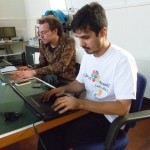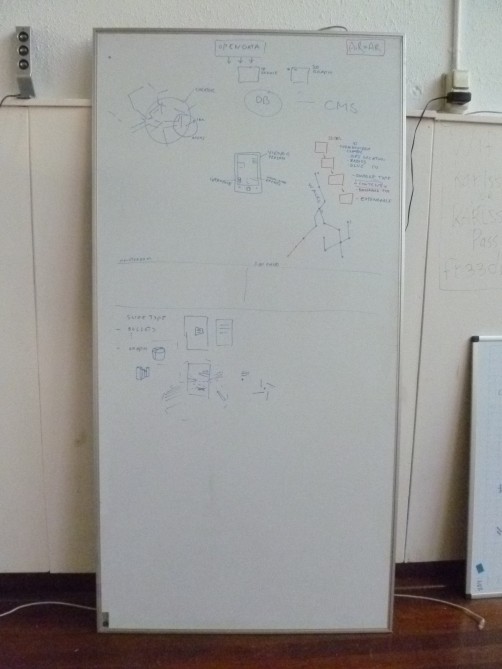12/03/2012
Interview 2
Julia Bac and Pixel (Amsterdam)
Do you believe that the fact of being here for already two weeks has influenced in the way that would normally work?
The project I am doing is together with Sander. I don’t think that the environment is influencing so much in my decision making process, but Sander’s way of work is different than mine. What is nice is that I want to experiment the way he works here and he wants to try the way we work over there. Because there is a different reality here related to the culture of mobility. Not only related to connection, but here people have effectively more access to technology. I have the impression that is more simple to target people with a project for mobile here than in Brazil.
The fact that I am visiting museums, visiting other spaces and the cultural activities that I am doing inspires me for new ideas. The experience of getting to know the city, having free time and thinking about the project in different environments, also influences the project. But, this will only be noticed ahead when we’ll have the software and when we start to add content to the software.
What is the current status of the project?
In general terms, what we want to do is already established. The basic lines of the project are ready. Now starts the phase of experimenting the project. Experimenting the possibilities of interaction, the development of a prototype.
We will see what it works and this would be kept in the first prototype of the project. I would say that this is the “prototyping experimental” phase of the project
You will develop two projects. What leaded you to do these two projects and not choose only one?
I wanted to experiment this online environment established here, develop something that would be good for this context and Sander wanted to develop something that would be good for Brazil. The first project is the “Powerpoint Walks” that is part of the proposal that Sander and me sent for the residency in Augmented Reality. The second is related to mobile technology, but is not an Augmented Reality. The second project will be developed if everything works well with the first one.
We want to present information that modifies the way people relate to the space, the information can be or not stories. We have been researching on open data, public data that we could use. But, so far we haven’t found anything that could be effectively relevant. Therefore, there is a challenge there… is something that we would like to try. But… well, Annet (one of the organizers) had already mentioned this back then, that it would be difficult to find data that would be interesting to trigger people to react with the system. We are just facing this aspect now.
Last Friday we have chosen the priorities of development. What should be done first and what comes afterwards. What are the initial priorities and what is accessory, than we continue following phase by phase.
And which are these phases?
The first phase would be to create a demo of the project. So, create a structure with the idea of the project. This demo would have the basics, the presentation of the content for the user, which in a way is an interaction. The first content would be still textual. From that point on we want to think about other types of content: graphic and with two or three dimensions, and also research more about open data. This is still experimentation. See what works and what doesn’t works. After this phase, we choose what should be kept in the project. And from that on we’ll build the content system management to enable people to collaborate in the project. After, think about how people will interact with each other using the system, create dialogs or making what is inside the system to dialogue. From stage of the development of the CSM, is already the implementation. After this we start doing the workshops.
The idea of gathering the public would be through these workshops?
Yes, in the beginning. In the workshops we would present the project and create content on the streets, we would walk around with the people on the streets. We wish to encourage people to continue to create content and spread the word about the project. From the moment of implementation of the CSM we already start to circulate and use content created by us, but this is parallel.
In Brazil you work with a team. How are you experiencing working with people from here? That you didn’t know before and also didn’t choose.
For the Jandig Project we did an open call. So, the experience of working with “strangers” happened already there, because I met people during the project. But Jandig was also an open process in which the participants were changing all the time. Some people would join and some would leave the project. In this project Sander and me have a commitment with the project. The idea of working together was a suggestion from the organizers, but me and Sander agreed to work together and share experiences, and I think both of us enjoyed this experience.
I like to work from home, and I have the impression that with Sander is the same. If we were working in different projects would be more difficult to have this exchange in the residency.
In the first interview you mentioned that you would like to disconnect a bit from Brazil, did you manage to do that?
Less than I would like to. I managed to disconnect a bit. Living in a different place is a way of disconnecting from Brazil and connecting in things here.
Do you think that you could plan and think on the proposal as much as you are doing if you were not here?
No. From there I wouldn’t have this residency experience. Also if I would have started the other way around would be much more difficult for me, having appointments and people trying to reach me. Is harder when you have an agenda. I planned this month to dedicate to the project and Sander planned for the next month, when he is going to Brazil.
In one of your videologs you mention about your process of creation…
I think that in the end I am working the way I am used to. Sander mentioned that he starts with the concept. But, the ideas are changing a lot, there is new ideas coming all the time. Some ideas we discover not to be so good and we look for what to prioritize. The work is changing, changing a lot, actually.
What would be a “not good” idea?
The idea of working with open data initially sounded a great idea and now we are facing the fact that might be not so good.
You mentioned that a few data you found were not so interesting. What would be the type of data that are not so interesting?
Show people how much the government spent building each public property, for example. How much was spent on building a bridge? This could even be part of the project, but doesn’t trigger people to interact with the project…there’s something missing. Actually, we are facing a difficulty on finding data. We talked to people working with open data in Brazil, we asked for information about which would be interesting data. But they didn’t reply. And if they didn’t reply probably is because they have difficulty in finding it. Because to make any sense, within the technological limitations existing, these data should be very specific. Related to specific areas of a city. This specificity is not easy to find and there is also a difficulty of dealing with these information.
Would you choose the same data in The Netherlands and in Brazil?
One of the things that, at least from my perspective is interesting, is a project that connects both countries. But, we still didn’t find something that would create this connection. One of the things we are considering to do is to show different perspectives of the city: I would show my perspective of Amsterdam and Sander would do the same in São Paulo. But this is our connection with the city and not of one city with the other, or one country to the other.
You presented the project to some people. What was the most interesting feedback that you had so far?
No one gave a feedback that changed completely the project. No one said: “why don’t you do it this way…”. I think they still need to see what will actually be, just explaining is not so simple. That is why we should work on the demo.
What is your goal for the last two weeks?
Develop the prototype. I think that at least have the prototype working the way we wanted. I would like to have this ready here, so we can modify the prototype there. So, the goal is to achieve a prototype in which I can have a walk through the city and put my experience in the system, but depending of the difficulties we will find during the process of work and what we will find out, we could finalize or not the prototype. Or maybe a great change would happen and we could decide to do something very different.
How this prototype would be like?
Would be to get the system to work, but fed only by Sander and me, without other people participating yet.


